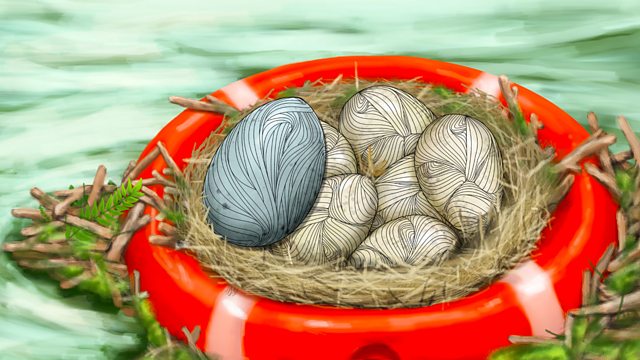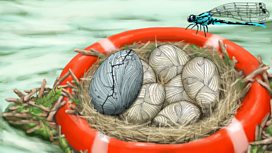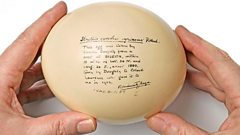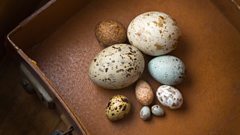Birds Eggs
Brett Westwood explores the role birds' eggs have played in religion, art and literature. From 2015
Beautiful, fragile, mysterious – we have always loved birds' eggs. Their colours are more of a hue, the patterning gorgeous to the eye, no wonder they have been collected from time immemorial. Eggs are a symbol of new life, a transformation that speaks to us of great truths beyond the purely biological. Easter eggs are a symbol of Christ's resurrection and were adopted from pagan beliefs about Ostara, the goddess connecting to various German Easter festivities.) The egg has been used as a metaphor for the origin of the universe in many traditions. We have used them in cooking – or eaten raw - since our time on earth. We have used the hard shell for decoration, and Faberge designed exquisite bejewelled eggs of gold and precious stones for the Tsars of Russia. A peculiar tradition of using eggs to record the varied faces of clowns arose just after WW2 when new clowns stamped their identity on the world by registering their unique features on eggs – there is now a clown egg museum. The natural variety in bird's eggs, even clutches in the same year, can be very different, is prized by collectors, determined to own the greatest diversity of any one species. Along with collecting comes money and then fraud. Pleasing to hold, beautiful on the eye, versatile in cooking, intriguing in nature, practical as well - eggs will always inspire us. From 2015
Original Producer Andrew Dawes
Archive Producer Andrew Dawes
Last on
![]()
Egg thefts and broken teeth. Birdnesting is Britain’s natural history secret.
![]()
The World According to Birds Eggs
Natural Histories comedy. A cuckoo meets his new mum for the first time. Awkward!
![]()
Chicks due any minute? Looking for your ideal nest? Don’t brood, browse!
Clips
-
![]()
The mysterious story of the Syrian ostrich egg
Duration: 03:59
-
![]()
The World According to Birds Eggs
Duration: 01:45
-
![]()
Why is the shape of an egg so naturally pleasing?
Duration: 02:27
Douglas Russell
In the egg and nest collection he is responsible for all aspects of curatorial care including visitors, enquiries, documentation and research on the collections to enhance their data.
Professor Tim Birkhead

He has authored and co-authored a large number of books including  and the Cambridge Encyclopedia of Ornithology.  His forthcoming book 'The Most Perfect Thing: Inside (and Outside) a Bird's Egg' is due to be published in April 2016 by Bloomsberry.
Dr Ed Connor

His research focuses on neural mechanisms underlying object vision and has shown how object structure is represented by populations of neurons in higher-level visual regions of the brain. In studies funded by the Hopkins Brain Science Institute, his laboratory has investigated the neural basis of shape aesthetics.
Ed Drewitt

He also works on a huge range of activities from taking schools fossil hunting to showing people wildlife from boats. He works a variety of organisations, including the and the .
Matthew Faint: "Mattie the Clown"

He began clowning 1971, working in and around London and overseas and for many years as a hospital clown. For the last 25 years he has been the curator of 's Museum and Archive at its two sites in Dalston in London and Wookey Hole in Somerset.
Professor Gavin Flood

He has recently published , a history of inwardness in Christianity, Hinduism and Buddhism (Oxford University Press, 2014).
Kieran McCarthy
He recently identified the original design source of the Constellation Egg. In 2010, he curated the exhibition , a private collection of Fabergé. Kieran was also instrumental in the republication of Dame Joan Evans, by Wartski in 2012.
Broadcasts
- Tue 1 Sep 2015 11:00±«Óătv Radio 4
- Mon 7 Sep 2015 21:00±«Óătv Radio 4
- Sun 28 Mar 2021 06:35±«Óătv Radio 4








